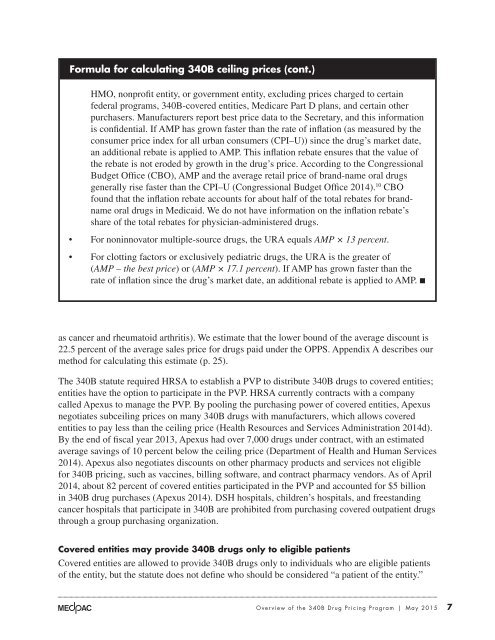Overview of the 340B Drug Pricing Program
1Mmfbin
1Mmfbin
Create successful ePaper yourself
Turn your PDF publications into a flip-book with our unique Google optimized e-Paper software.
Formula for calculating <strong>340B</strong> ceiling prices (cont.)<br />
HMO, nonpr<strong>of</strong>it entity, or government entity, excluding prices charged to certain<br />
federal programs, <strong>340B</strong>-covered entities, Medicare Part D plans, and certain o<strong>the</strong>r<br />
purchasers. Manufacturers report best price data to <strong>the</strong> Secretary, and this information<br />
is confidential. If AMP has grown faster than <strong>the</strong> rate <strong>of</strong> inflation (as measured by <strong>the</strong><br />
consumer price index for all urban consumers (CPI–U)) since <strong>the</strong> drug’s market date,<br />
an additional rebate is applied to AMP. This inflation rebate ensures that <strong>the</strong> value <strong>of</strong><br />
<strong>the</strong> rebate is not eroded by growth in <strong>the</strong> drug’s price. According to <strong>the</strong> Congressional<br />
Budget Office (CBO), AMP and <strong>the</strong> average retail price <strong>of</strong> brand-name oral drugs<br />
generally rise faster than <strong>the</strong> CPI–U (Congressional Budget Office 2014). 10 CBO<br />
found that <strong>the</strong> inflation rebate accounts for about half <strong>of</strong> <strong>the</strong> total rebates for brandname<br />
oral drugs in Medicaid. We do not have information on <strong>the</strong> inflation rebate’s<br />
share <strong>of</strong> <strong>the</strong> total rebates for physician-administered drugs.<br />
• For noninnovator multiple-source drugs, <strong>the</strong> URA equals AMP × 13 percent.<br />
• For clotting factors or exclusively pediatric drugs, <strong>the</strong> URA is <strong>the</strong> greater <strong>of</strong><br />
(AMP – <strong>the</strong> best price) or (AMP × 17.1 percent). If AMP has grown faster than <strong>the</strong><br />
rate <strong>of</strong> inflation since <strong>the</strong> drug’s market date, an additional rebate is applied to AMP. ■<br />
as cancer and rheumatoid arthritis). We estimate that <strong>the</strong> lower bound <strong>of</strong> <strong>the</strong> average discount is<br />
22.5 percent <strong>of</strong> <strong>the</strong> average sales price for drugs paid under <strong>the</strong> OPPS. Appendix A describes our<br />
method for calculating this estimate (p. 25).<br />
The <strong>340B</strong> statute required HRSA to establish a PVP to distribute <strong>340B</strong> drugs to covered entities;<br />
entities have <strong>the</strong> option to participate in <strong>the</strong> PVP. HRSA currently contracts with a company<br />
called Apexus to manage <strong>the</strong> PVP. By pooling <strong>the</strong> purchasing power <strong>of</strong> covered entities, Apexus<br />
negotiates subceiling prices on many <strong>340B</strong> drugs with manufacturers, which allows covered<br />
entities to pay less than <strong>the</strong> ceiling price (Health Resources and Services Administration 2014d).<br />
By <strong>the</strong> end <strong>of</strong> fiscal year 2013, Apexus had over 7,000 drugs under contract, with an estimated<br />
average savings <strong>of</strong> 10 percent below <strong>the</strong> ceiling price (Department <strong>of</strong> Health and Human Services<br />
2014). Apexus also negotiates discounts on o<strong>the</strong>r pharmacy products and services not eligible<br />
for <strong>340B</strong> pricing, such as vaccines, billing s<strong>of</strong>tware, and contract pharmacy vendors. As <strong>of</strong> April<br />
2014, about 82 percent <strong>of</strong> covered entities participated in <strong>the</strong> PVP and accounted for $5 billion<br />
in <strong>340B</strong> drug purchases (Apexus 2014). DSH hospitals, children’s hospitals, and freestanding<br />
cancer hospitals that participate in <strong>340B</strong> are prohibited from purchasing covered outpatient drugs<br />
through a group purchasing organization.<br />
Covered entities may provide <strong>340B</strong> drugs only to eligible patients<br />
Covered entities are allowed to provide <strong>340B</strong> drugs only to individuals who are eligible patients<br />
<strong>of</strong> <strong>the</strong> entity, but <strong>the</strong> statute does not define who should be considered “a patient <strong>of</strong> <strong>the</strong> entity.”<br />
<strong>Overview</strong> <strong>of</strong> <strong>the</strong> <strong>340B</strong> <strong>Drug</strong> <strong>Pricing</strong> <strong>Program</strong> | May 2015 7


